The AMD Llano Notebook Review: Competing in the Mobile Market
by Jarred Walton & Anand Lal Shimpi on June 14, 2011 12:01 AM ESTBattery Life: All Day Computing
AMD makes a point of their mobile offerings (A/C/E-series APUs) all offering “all day computing”, with a note that “all day” is defined as eight hours or more. While that’s easy to do with a gigantic battery, doing so with the typical 48/56Wh batteries in mainstream laptops is a lot more difficult. One of their test notebooks apparently manages around 10.5 hours (best-case) with a 62Wh battery, compared to 6.5 hours for a similar Core i5-2410M laptop. Without specifics on all the settings, we’ll just say that our results for “similar” laptops don’t show nearly the disparity AMD achieved, but the important point is that AMD is finally competitive in battery life.
We ran our usual series of battery life tests, with the LCDs set for ~100 nits (70% brightness for the Llano laptop). We shut off WiFi for the idle test and mute audio; the Internet test is run over WiFi and repeatedly loads four tabs of content every minute, again with audio muted; finally, the H.264 playback result is done with a set of earbuds connected and WiFi disabled. Here’s how the Llano laptop stacks up to some recently reviewed laptops—you can compare Llano with other laptops in Mobile Bench.
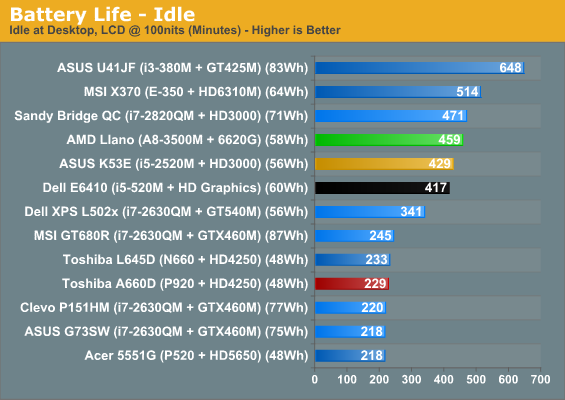

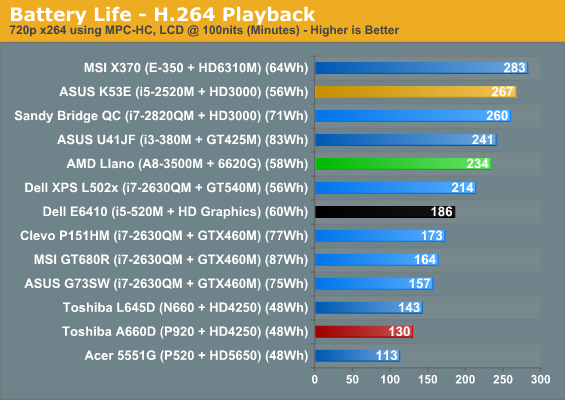
Starting with pure battery life, only three laptops consistently offer longer battery life than the Llano system: the ASUS U41JF, MSI’s X370, and the quad-core Sandy Bridge notebook. Also, the ASUS K53E boasts better battery life in the H.264 playback test, which for whatever reason is a test where SNB has proved particularly potent. Intel’s DXVA decode may be efficient, but it's also possible it's doing less work; we're running the test again with all of AMD's video enhancement features turned off. [Update: I retested with all the AMD video enhancement features disabled, and battery life didn't change, so Intel is simply more efficient at H.264 decoding with SNB.]
Back to the discussion of battery life: all three of the laptops that beat Llano have the advantage of slightly to moderately higher battery capacities, so the comparison isn’t entirely fair. Let’s level the playing field by looking at relative battery life.
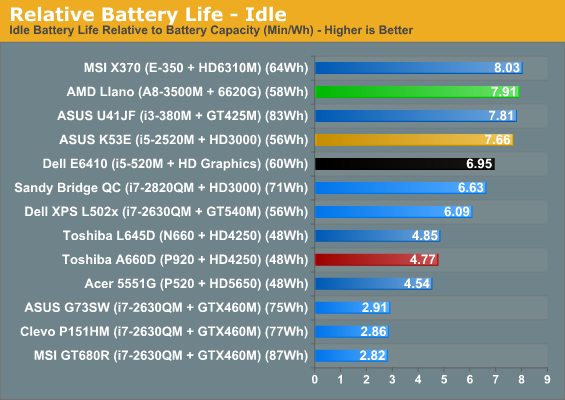
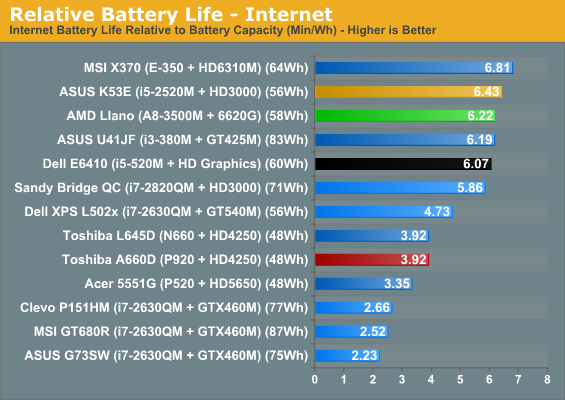
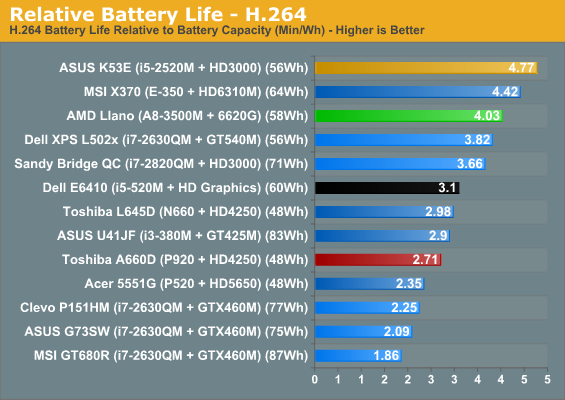
Rather amazing is that Llano actually rises to the top of the charts in the Idle test, and it’s only slightly behind the competition in the other two tests. Considering the X370 is equipped with an E-350 APU, the fact that Llano is even close is surprising. While we should note that the X370 wasn’t the most efficient of the E-350 laptops we’ve tested, we also need to point out that the 13.3” LCD is a lot closer to the 14” panel in the Llano notebook than the 11.6” panels used in the Sony YB and HP dm1z. The dual-core SNB notebook still leads in the H.264 test, and considering it has a 15.6” panel we’d say that relative battery life is very similar between the two.
We also want to talk about AMD’s claims of “all day battery life”. If we accept their definition of 8+ hours, the test laptop doesn’t actually hit that mark in our idle test. We did run the same test again at 40% LCD brightness (around 60 nits) and managed eight hours exactly, but that’s in an absolutely best-case test. For Internet surfing, which represents a more useful metric, the best way to get 8+ hours is demonstrated by ASUS’ U41JF: stuff in a higher capacity battery!
Rounding out the battery life discussion, we also tested battery life while looping 3DMark06 at native resolution (1366x768). This represents a reasonable 3D gaming scenario, and Llano still managed a reasonable 161 minutes. Considering graphics performance is a healthy step up from what Intel’s HD 3000 offers and that AMD manages double the battery life under gaming situations compared to the K53E, mobile gaming is clearly a win.
Overall, for the first time in a long time, AMD is able to offer battery life that competes with and even exceeds what Intel offers with their current mainstream offerings. There are of course a bunch of lower power Intel CPUs we could discuss, but looking at the 35W TDP parts the combination of 32nm and power gating has brought AMD back into the discussion. Even more interesting is that you should be able to get something like our test laptop for $600, possibly less, compared to dual-core SNB i5 laptops that start at $700. But then, perhaps Core i5 isn’t the best comparison for quad-core Llano, despite what AMD might like to say? Let’s move on to general performance and gaming discussions before we decide which mobile part is the “best”.










177 Comments
View All Comments
JarredWalton - Tuesday, June 14, 2011 - link
Totally agree with the pricing. The highest performance A8 laptops are going to need to be $700 with fGPU only, and maybe $800 with dGPU, because that's where dual-core i5 + Optimus laptops are currently sitting.Of course, I'd still pay more for good build quality and a nice LCD and keyboard.
Oh, and the people saying CPU is the be-all, end-all... well, even though I have a couple Core i7 Bloomfield systems in my house (and many Core i5/i7 laptops), my primary work machine is running... Core 2 QX6700 (@3.2GHz) with an HD 5670 GPU and 4GB RAM. The area I want to upgrade the most is storage (currently using RAID0 Raptor 150GB), but I have no desire to reformat and start transferring apps to another PC, so I continue to plug along on the Raptors. This CPU is now over four years old, and yet the only thing I really don't like is the HDD thrashing and slow POST times.
ionave - Thursday, June 16, 2011 - link
None of those GPU's match the power of the 6620, which you can find in even the A6 series, so your point is invalid.Dribble - Wednesday, June 15, 2011 - link
Actually you can normally tell quite easily which laptop has the slower cpu. It's the one with the fan whining away. With laptops having a more powerful processor that isn't having to work so hard is important just to keep the thing quiet.As for cpu power - well windows and it's software just isn't that efficient. Even a fairly complex word 2010 doc (few pictures/charts/etc) can start to feel slow on a 2.5Ghz C2D (I should know my laptop has a 2.4Ghz C2D). The flash games my kids seem to be forever finding are also cpu only and will run it flat out and the game won't seem as smooth as it would on a faster machine.
Sure you can get by with a slower machine, but it doesn't make for such a pleasant experience.
It has been the case since PC's arrived that over time software needs more and more power. e.g. I could run word 6 on a 486, I now really need a dual core 2Ghz machine to even run word 2010. I don't see that changing hence the faster your cpu the longer your pc will remain usable.
lukarak - Wednesday, June 15, 2011 - link
I've been using a 2007 tech MacBook white up until a few months ago with a 2.0 GHz C2D. Over time i upgraded it to include 6 GB of memory, a 64 GB SSD + 500 GB HDD, and then i transitioned to a 2011 MPB 13 with a SNB CPU and 4 GB of memory. Aside from a better screen, once i put in the SSD, i couldn't see the diference in speed. I usually use a lot of VM, use Eclipse and XCode, and most of the time watch 720p and the more than 3 years newer CPU isn't all that revolutionary. Sure, it may not use 30ish % of the CPU to play movies, but only 20ish, but until that's 50ish% when the fan gets louder it doesn't really matter for me.ionave - Thursday, June 16, 2011 - link
The CPU looks relatively slow to the i5/i7, but its really not that slow. Seriously. Compare it to an atom and see that its not that bad.ionave - Thursday, June 16, 2011 - link
The CPU isn't even bad. I don't know what you guys are all on but A8 cores are improved phenom II x4 cores... I would say its about the same performance as the i5 series. All the benchmarks online are measured on the WORST A8 chip, which has the worst CPU performance. All of the reviews are on A8-3500M. Just wait until the A8-3850 gets benchmarked.All I'm saying is that its not fair to compare the worst A8 to the best i5 or best i7, plain and simple.
sundancerx - Tuesday, June 14, 2011 - link
for most of the charts, yellow bar is assigned to INTEL asus k53e(i5-2520m+hd3000), but on asymetrical crossfire, this is assigned to AMD llano (18-3500m+crossfire). kind of confusing if you dont pay attention or am i the one confused?JarredWalton - Tuesday, June 14, 2011 - link
Dark yellow = K53E, bright yellow = CrossFire. If you have a different color you think would work, I'll be happy to change it. Purple? Brown? Orange?adrien - Tuesday, June 14, 2011 - link
I agree Brazos looks less interesting now but it still has one huge advantage: price. If Llano notebooks are going to sell for $600 (or $500), Brazos are 40% less expensive.JarredWalton - Tuesday, June 14, 2011 - link
Brazos E-350 (which is already 60% faster than C-50) start at around $425. They come with 2GB RAM and a 250GB HDD. AMD is saying $500 as the target price for A4, $600 for A6, and $700 for A8, but I suspect we'll see lower than that by at least $50. So if your choice is Brazos E-350 for $425 or Llano A4 for $450, and the Llano packs 4GB RAM and a 500GB HDD, there's no competition--though size will of course be another factor. I figure Llano will bottom out at 13.3-inch screens where Brazos is in 11.6" and 12.1". Personally, I'd never buy a 10" netbook; I just can use them comfortably. I'm happiest with 13.3" or 14" laptops.